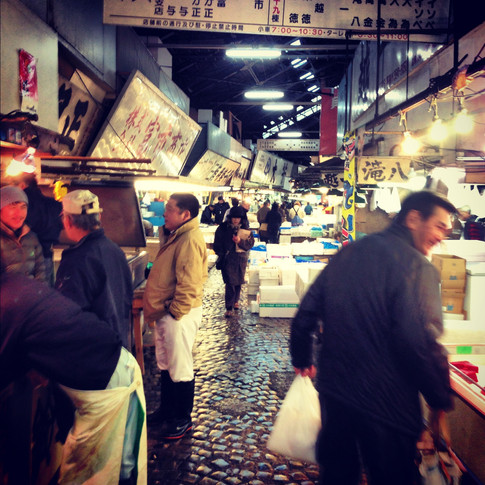The Full Tokyo Experience
- thebrieadventure

- Oct 22, 2018
- 7 min read
The traffic filled streets and flashing lights reaching stories high and as far out as the eye can see was my introduction to Tokyo. An hour away from the city, the massive and lively suburbs by the airport began to prepare me for the enormity of Tokyo. Wide eyed and a bit overwhelmed I stepped off the train around midnight in Shinjuku, the chaotic hub of the city. Even after I returned three more times, coming into the city was always a sight to behold. Just like New York or any other massive urban city, Tokyo never sleeps and barely even slows down when the sun sets. After living in Japan for a few years, here are a few of my favorites from its largest city:
Tsukiji Fish Market and Sushi
Located on the Sumida River, Tsukiji is the world's largest fish and seafood market where approximately five million lbs of seafood is sold daily. As an early riser, the market opening hours still had me yawning as I had to get up around 3am to make the trek across town in order to catch the action in full swing around 4.
It was loud, bright, and the giant warehouse seemed endlessly filled with stalls and busy workers cleaning the fish and preparing them for sale. After exploring around the maze of stalls and trying to stay out of the way of carts and buckets being hurriedly pushed through the small alleys, I continued on to some of the smallest world renown sushi restaurants on the outer edge of Tsukiji. While I am a huge sushi lover I do not normally opt for it at breakfast, yet this was the perfect occasion for an exception. The fresh fish that had just been caught a few hours before was delivered directly to the chefs who promptly chopped them up to serve.

It was easy to find the famous sushi restaurants since there were already lines queuing up out front with nearly a 45 min wait at 0530 in the morning! Sleepily I waited my turn before crowding in behind the few other customers in the narrow seating area. The green tea was a welcome start after the chilly wait outside, but the sushi and sashimi were the show stoppers. Before moving to Japan I had not been much of a raw fish fan, but living in Japan quickly changed my mind after being introduced to the substantially higher quality that was readily available. Now I am confident that even the unbeliever would enjoy the meal that was served here comprised of perfect rice and obviously only the freshest of seafood. While it was definitely worth the early morning to get this experience, unfortunately the famous Tsukiji closed in October 2018 but it is scheduled to reopen at the Toyosu Fish Market across town.
Kamakura

An hour bus ride out of the city to the south is a big Buddha perched on a hill. In the usual manner of how I discover awesome destinations, I saw a photo of this online and added it to my list. This enormous bronze statue of Amida Buddha is located in the middle of Kotokuin Temple grounds where visitors are welcome to walk around. This statue has become one of Tokyo's iconic symbol, but surprisingly there were not too many people overcrowding the temple making it an excellent and easy excursion from the chaos of the city.
Tokyo tower
A bright red and quite frankly an uglier cousin to the Eiffel Tower, the Tokyo Tower does offer a great view of the city sprawling out in all directions below. It is a popular tourist spot with lots of places to take pictures and a glass panel to stand on that is supposed to prove your nerve (which I jumped on much to the horror of most of the crowd). The best part about it though is that it is a great spot to catch the sunset and golden hour. As the sun dips behind Mt. Fuji in the far distance and the city lights begin coming to alive, the city transforms into a sea of city lights flickering to life before your eyes.
Sumo Wrestling

Watching this sport on TV simply does not do justice to the pure mass of these athletes. Consuming over 8,000 calories daily on average, these fighters are not just bulky but look like the Mountain from Game of Thrones. They are huge. Tickets to these events sell out quickly so I was thrilled when a co-worker mentioned that he had spare tickets for sale which I jumped on last minute and within 24 hours had landed in Tokyo for the event. Unlike major sporting events that I am accustomed to attending, there were no seats in this stadium. Instead, fans had separate boxes in which they sat or kneeled to observe the matches. Not the most comfortable way to watch an event, but it certainly lended to the authentic feel. The festivities begin with ceremonial dances where all of the players come out and join in together in chants and dances before the fighting begins. When I first arrived I was very unfamiliar with the rules. While it would certainly be helpful to go in to the match with some understanding, most of it quickly becomes clear and after a day I felt like an expert fan cheering on my favorite behemoths to victory and honor.
Climbing Mt. Fuji

One of Japan’s iconic landmarks, Mt. Fuji is visible in the distant horizon from Tokyo. It is easily accessible from the city either by bus or train. The mountain is 12,388 feet and takes on average 6 and a half hours to hike up. The official hiking season is from the beginning of July to mid-September when it closes due to cold weather and snowy conditions, but even during the summer the temperature drops quickly so warming layers are definitely needed. During my time living in Okinawa, this was always on my list of things to do especially after seeing many of my friends’ photos from their climbs. Finally, on my third trip to Tokyo I found a few friends who were also interested in hiking to meet up for the climb. Although the experience definitely would have been more enjoyable if the weather had cooperated hiking Mt. Fuji was still a very memorable trip. Despite the fact that it was storming and the mountain was technically closed, we still made it to the top!
Capsule Hotels

One of the most unique hotels (and probably just as comfortable as a traditional Japanese hotel that offers mats on the floor), capsules are small bed spaces available for travelers. Usually stacked two high and filling a hallway, these private compartments offer a bed, just enough space to sit up, and usually a light with an outlet. Some of the fancier ones even have mini TVs in them. They are not for the claustrophobic though as the space for moving around is very limited and once the curtain is closed it becomes a very dark confined space. My first one was not quite big enough to sit up in probably because it was designed for a Japanese person and not a 5'10 giant American girl, but it felt a bit like what I imagine being trapped in a coffin would feel like. The following ones I rented were much roomier and I continued to use capsules on subsequent visits because they are by far the cheapest accommodations in the city especially since I just needed a spot to catch a few zzz.
Ninja restaurant

Tokyo offers several famous extravagantly themed restaurants throughout the city ranging from the popular LED robot show to small cafes filled with cats to play with while enjoying a coffee. One of the less known thematic restaurants is Ninja. We arrived at a plain nondescript building and passed the restaurant twice before noticing the small lit up sign. After stepping inside the plain door we were greeted by masked hosts in a closet sized dimly lit room. Soon we were escorted across a bridge and through a maze of dark hallways into our own small private room. The attention to detail made the experience quite memorable from the waiters who seemingly appeared out of thin air (coming through concealed entrances), to the menus that disintegrated in seconds in front of us after we made our meal selections. Waiters popped in and out of random doors and holes in the room that blended in seamlessly to the walls to deliver our dinner and then quickly disappear. It was definitely a fun experience and one that is unique to Tokyo.
Hidden Clubs

In a similar style to the Ninja Restaurant or speak-easys back in the U.S., Tokyo has several hidden clubs around the city. This by no means indicates that these establishments are small they are just well concealed from passerby on the street. Womb is the perfect example of this as a multi story mega club that is marked only by a small concrete sign on a side street. When we arrived, we were fairly confident that Google Maps had led us astray until we went down a non-descriptive staircase that opened into a sea of people. The club was unremarkable and nearly unidentifiable from the exterior, but once inside the DJs kept blasting music until the early hours of the morning when couples eventually drifted off to the near-by "Rabbitt Hotels," yet another oddity of the Tokyo nightlife.
Shibuya Crossing
One of the most famous intersections in the world, Shibuya is internationally recognized as one of the busiest street crossings. Featured in The Fast and Furious, this is the over-crowded intersection that the drivers drifted through parting the sea of people. Every few minutes when the walk signs are illuminated, thousands of pedestrians instantly fill this sprawling intersection. The entire area around this intersection remains lively 24 hours a day with flashing lights and mayhem filled streets. The best vantage point to watch the chaos is from the second story Starbucks across from the Shibuya Station, but this branch remains one of the busiest in the world!
Also do not miss the statue of Hachiko, the faithful dog that would wait by the train station every day for his owner to come home from work, even years after his owner had passed away. The statue commemorates "the most loyal dog" which has ironically become one of the popular meeting places for people at this otherwise chaotic crossing point.




























Comments